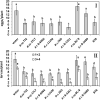Endophytic Bacillus spp. as a Prospective Biological Tool for Control of Viral Diseases and Non-vector Leptinotarsa decemlineata Say. in Solanum tuberosum L
- PMID: 33178153
- PMCID: PMC7593271
- DOI: 10.3389/fmicb.2020.569457
Endophytic Bacillus spp. as a Prospective Biological Tool for Control of Viral Diseases and Non-vector Leptinotarsa decemlineata Say. in Solanum tuberosum L
Abstract
Viral diseases and their damage causing significant loss to economically important crops have increased by several folds during the last decade. All the conventional approaches are not able to eradicate the viral infection. Therefore, there is a need to look for efficient and eco-friendly viral disease-preventive measures. The genomic material of the majority of deleterious viruses of higher plants is RNA. One of the possible measures to control viruses is the use of ribonucleases (RNases), which can cleave RNA in the viral genome. Based on this, we investigated the RNase activity of endophytic Bacillus spp., which can enrich in 103-105 colony-forming units per gram of wet mass of aboveground part of potato plants. A high level of RNase activity was observed in the culture medium of Bacillus thuringiensis B-6066, Bacillus sp. STL-7, Bacillus sp. TS2, and Bacillus subtilis 26D. B. thuringiensis B-5351 had low RNase activity but high ability to colonize internal plant tissues, Bacillus sp. STL-7 with high RNase activity have relatively low number of cells in internal tissues of plants. B. thuringiensis B-6066, B. subtilis 26D, and Bacillus sp. TS stimulate RNase activity in potato plants for a long time after application. Strains with high ability to colonize internal plant tissues combined with high RNase activity reduced severity of viral diseases symptoms on plants and reduced the incidence of potato viruses M, S, and Y. It is worth noting that Bacillus spp. under investigation reduced the number of Leptinotarsa decemlineata Say. egg clusters and larvae on treated plants and showed antifeedant activity. This results in increase of potato productivity mainly in the fraction of major tubers. B. subtilis 26D and Bacillus sp. TS2 combining endophytic lifestyle, RNase, and antifeedant activity may become the basis for the development of biocontrol agents for plant protection.
Keywords: Bacillus; RNases; Solanum tuberosum; endophyte; viruses.
Copyright © 2020 Sorokan, Cherepanova, Burkhanova, Veselova, Rumyantsev, Alekseev, Mardanshin, Sarvarova, Khairullin, Benkovskaya and Maksimov.
Figures







Similar articles
-
Endophytic Strain Bacillus subtilis 26DCryChS Producing Cry1Ia Toxin from Bacillus thuringiensis Promotes Multifaceted Potato Defense against Phytophthora infestans (Mont.) de Bary and Pest Leptinotarsa decemlineata Say.Plants (Basel). 2020 Aug 28;9(9):1115. doi: 10.3390/plants9091115. Plants (Basel). 2020. PMID: 32872225 Free PMC article.
-
Endophytic Strain Bacillus subtilis 26D Increases Levels of Phytohormones and Repairs Growth of Potato Plants after Colorado Potato Beetle Damage.Plants (Basel). 2021 May 5;10(5):923. doi: 10.3390/plants10050923. Plants (Basel). 2021. PMID: 34063145 Free PMC article.
-
Effects of Endophytic Bacillus Subtilis and Salicylic Acid on Postharvest Diseases (Phytophthora infestans, Fusarium oxysporum) Development in Stored Potato Tubers.Plants (Basel). 2020 Jan 7;9(1):76. doi: 10.3390/plants9010076. Plants (Basel). 2020. PMID: 31936027 Free PMC article.
-
Mechanisms of Plant Tolerance to RNA Viruses Induced by Plant-Growth-Promoting Microorganisms.Plants (Basel). 2019 Dec 5;8(12):575. doi: 10.3390/plants8120575. Plants (Basel). 2019. PMID: 31817560 Free PMC article. Review.
-
Modern Techniques in Colorado Potato Beetle (Leptinotarsa decemlineata Say) Control and Resistance Management: History Review and Future Perspectives.Insects. 2020 Sep 1;11(9):581. doi: 10.3390/insects11090581. Insects. 2020. PMID: 32882790 Free PMC article. Review.
Cited by
-
Deciphering the antiviral nature of endophytic Bacillus spp. against groundnut bud necrosis virus in cowpea and tomato.Front Microbiol. 2024 Jun 6;15:1410677. doi: 10.3389/fmicb.2024.1410677. eCollection 2024. Front Microbiol. 2024. PMID: 38903787 Free PMC article.
-
Plant-Associated Bacillus thuringiensis and Bacillus cereus: Inside Agents for Biocontrol and Genetic Recombination in Phytomicrobiome.Plants (Basel). 2023 Nov 30;12(23):4037. doi: 10.3390/plants12234037. Plants (Basel). 2023. PMID: 38068672 Free PMC article. Review.
-
Bacillus subtilis 26D Triggers Induced Systemic Resistance against Rhopalosiphum padi L. by Regulating the Expression of Genes AGO, DCL and microRNA in Bread Spring Wheat.Microorganisms. 2023 Dec 14;11(12):2983. doi: 10.3390/microorganisms11122983. Microorganisms. 2023. PMID: 38138127 Free PMC article.
-
By Modulating the Hormonal Balance and Ribonuclease Activity of Tomato Plants Bacillus subtilis Induces Defense Response against Potato Virus X and Potato Virus Y.Biomolecules. 2022 Feb 10;12(2):288. doi: 10.3390/biom12020288. Biomolecules. 2022. PMID: 35204789 Free PMC article.
-
Additive Effect of the Composition of Endophytic Bacteria Bacillus subtilis on Systemic Resistance of Wheat against Greenbug Aphid Schizaphis graminum Due to Lipopeptides.Life (Basel). 2023 Jan 11;13(1):214. doi: 10.3390/life13010214. Life (Basel). 2023. PMID: 36676163 Free PMC article.
References
-
- Alyokhin A., Baker M., Mota-Sanchez D., Dively G., Grafius E. (2008). Colorado potato beetle resistance to insecticides. Am. J. Potato Res. 85 395–413. 10.1007/s12230-008-9052-0 - DOI
-
- Aydi Ben Abdallah R., Jabnoun-Khlareddine H., Nefzi A., Mokni-Tlili S., Daami-Remadi M. (2016). Biocontrol of Fusarium wilt and growth promotion of tomato plants using endophytic bacteria isolated from Solanum elaeagnifolium stems. J. Phytopathol. 164 811–824. 10.1111/jph.12501 - DOI
-
- Bakhvalova S. A., Tsvetkova V. P., Shpatova T. V., Shternshis M. V., Grishechkina S. D. (2015). Ecological interactions in the system: entomopathogenic bacterium Bacillus thuringiensis—phytopathogenic fungus Rhizoctonia solani—host plant Solanum tuberosum. Contemp. Problems Ecol. 8 534–539. 10.1134/S1995425515040034 - DOI
-
- Bly U., Woodard H., Gelderman R. (2009). Biological Inoculants and Other Products for Soybeans During 2009 (44309 and 44409). Brookings, SD: South Dakota State University.
LinkOut - more resources
Full Text Sources
Miscellaneous

